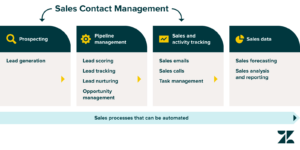Sales teams often make five common sales automation mistakes, but these can be easily avoided. To avoid these mistakes, sales teams must focus on proper training, setting realistic goals, utilizing the right tools, prioritizing personalized communication, and regularly analyzing and optimizing their processes.
Implementing these strategies can greatly improve sales automation efficiency and help sales teams achieve better results.
Mistake #1: Lack Of Planning And Strategy
Lack of planning and strategy can be a costly mistake for sales teams. Avoid this pitfall by carefully mapping out a solid plan and implementing a strategic approach to sales automation.
One of the biggest mistakes sales teams make is a lack of planning and strategy. Without a well-defined plan in place, a sales team is essentially flying blind, which can lead to wasted time, efforts, and missed opportunities. In order to avoid this common pitfall, sales teams need to focus on two key areas: inadequate sales process documentation and neglecting metrics and KPIs.
Inadequate Sales Process Documentation
Without proper documentation, it is difficult for sales teams to have a clear understanding of their sales process, resulting in confusion and inefficiency. Sales process documentation outlines the step-by-step approach to closing a deal, including qualification criteria, lead generation strategies, and the sales cycle timeline. By clearly documenting these processes, sales teams can ensure consistency, transparency, and effective communication.
To avoid inadequate sales process documentation, sales teams should:
- Create a comprehensive sales playbook that outlines the entire sales process from start to finish.
- Include detailed information about each stage of the process, including key activities, required documentation, and expected outcomes.
- Regularly update and review the sales playbook to incorporate feedback and best practices from the team.
Neglecting Metrics And Kpis
Metrics and key performance indicators (KPIs) play a crucial role in evaluating sales team performance and identifying areas for improvement. Neglecting these metrics can result in missed opportunities and an inability to measure the effectiveness of sales strategies. By tracking and analyzing key metrics and KPIs, sales teams can make data-driven decisions and optimize their processes for better results.
To avoid neglecting metrics and KPIs, sales teams should:
- Identify the key metrics and KPIs that align with their specific goals and objectives.
- Implement a system to accurately track and measure these metrics, such as a CRM platform or sales software.
- Regularly review and analyze the data to identify trends, patterns, and areas for improvement.
- Use the insights gathered from the data to adjust sales strategies and tactics accordingly.

Credit: www.facebook.com
Mistake #2: Not Utilizing Sales Automation Tools Effectively
Sales teams often make the mistake of not effectively utilizing sales automation tools, which can hinder their productivity and performance. By harnessing the power of these tools, sales teams can streamline their processes, automate repetitive tasks, and improve overall efficiency.
Avoiding this mistake can lead to better sales results and increased success for the team.
Choosing The Wrong Sales Automation Software
When it comes to using sales automation tools effectively, one major mistake that sales teams often make is choosing the wrong software. Without careful consideration, businesses can end up investing in software that does not align with their specific needs and goals. This not only wastes valuable time and resources but also hinders their ability to maximize efficiency and productivity.
In order to avoid this common pitfall, it is crucial to conduct thorough research and evaluation before making a decision. Start by clearly defining your sales requirements and objectives. Identify the key features and functionalities that are essential for your team’s success. Then, examine different sales automation software options that offer these functionalities.
Consider factors such as ease of use, scalability, integration capabilities, and customer support. Look for reviews and feedback from other businesses in your industry to gain insights into the software’s performance. By taking these measures, you can ensure that you select the right sales automation software that best suits your team’s needs.
Insufficient Training And Adoption
Another mistake that sales teams frequently make when it comes to utilizing sales automation tools effectively is providing insufficient training and promoting low adoption rates.
Implementing new software requires proper training to ensure that your sales team understands how to utilize all of its features and functionalities. Failing to invest enough time and resources in training can lead to underutilization of the software and ultimately hinder its effectiveness.
To avoid this mistake, create a comprehensive training plan that covers all aspects of the software. Conduct training sessions with your team, offering hands-on experience and guidance. Additionally, provide ongoing support and resources to address any questions or challenges that may arise.
In order to promote adoption and encourage your team to embrace the new tools, clearly communicate the benefits and advantages of using sales automation software. Show how it can simplify their workflow, save time, and improve their overall efficiency. By emphasizing the positive impact and providing ongoing support, you can ensure that your sales team fully embraces sales automation tools and utilizes them effectively.
Mistake #3: Over-automation And Impersonalization
One of the biggest mistakes sales teams make when implementing sales automation is over-reliance on automation and failing to personalize their communication. While automation can be a powerful tool, it’s important to find the right balance to ensure that your sales efforts still come across as authentic and personal. In this section, we’ll discuss two common pitfalls associated with over-automation and impersonalization and provide strategies to avoid them.
Using Too Many Automated Touchpoints
Automation has revolutionized the way sales teams operate. With the ability to schedule emails, social media posts, and follow-up sequences, it’s easy to get carried away and automate every interaction. However, bombarding your prospects with automated touchpoints can quickly backfire and lead to disengagement.
To avoid this mistake:
- Consider the frequency of your touchpoints.
- Ensure that each touchpoint adds value and relevance to the prospect’s journey.
- Implement a variety of touchpoints, including personalized emails, phone calls, and social media messages.
- Keep an eye on response rates and engagement metrics to gauge the effectiveness of your touchpoints.
Failure To Personalize Communication
Impersonalization is a sales killer. Generic emails and messages lacking personalization can make your prospects feel like just another number, diminishing the chances of building meaningful relationships and closing deals.
To ensure personalization:
- Segment your leads based on specific criteria such as demographics, industry, or purchasing behavior.
- Use dynamic content and merge tags to insert personalized information into your emails and messages.
- Consider using marketing automation software that allows for intelligent personalization based on prospect behavior and preferences.
- Always conduct thorough research on your prospects before reaching out, and tailor your communication accordingly.
In conclusion, sales automation can be a game-changer for your sales team, but it’s crucial to avoid the pitfalls of over-automation and impersonalization. By finding the right balance and prioritizing personalized communication, you can build stronger relationships with prospects and increase sales success.

Credit: www.linkedin.com
Mistake #4: Neglecting Human Connection
Ignoring the importance of human connections is a common mistake in sales automation. However, it can be avoided by prioritizing personal interactions and building strong relationships with customers.
In today’s digital age, where automation plays a significant role in sales processes, it’s easy to forget about the importance of human connection. However, neglecting human connection is a crucial mistake that sales teams need to avoid if they want to build strong and long-lasting relationships with their prospects and customers.
Relying Solely On Automation
While automation can streamline and simplify sales tasks, relying solely on it can lead to a lack of personalization and engagement. Customers want to feel heard and understood, and automated interactions can often make them feel like just another number in the system. To avoid this mistake, it’s important to strike a balance between automation and human interaction. Use automation tools to handle repetitive and time-consuming tasks, such as data entry and follow-up emails, but make sure to personalize your interactions whenever possible. Take the time to understand your customers’ needs and tailor your approach accordingly.
Ignoring Relationship-building Activities
Building relationships with customers is essential for sales success. However, it’s easy to get caught up in the efficiency of automation and neglect relationship-building activities. These activities include networking, attending events, and having meaningful conversations with prospects and customers. To avoid this mistake, make relationship-building a priority. Set aside time each week to connect with your customers on a personal level. Send personalized emails, make phone calls, or meet face-to-face when possible. Remember, the foundation of a successful sales process lies in building trust and rapport with your customers. Useful activities to avoid Mistake #4: – Attend industry conferences and events to network with potential customers and industry experts. – Engage with your customers on social media platforms like LinkedIn to strengthen your professional relationships. – Conduct customer surveys or interviews to understand their pain points and preferences better. – Schedule regular check-ins with your customers to address any concerns or problems they may have. By actively participating in relationship-building activities, you can foster a sense of loyalty and create lasting connections with your customers. Remember, while automation can enhance your sales process, it should not replace the human touch. Customers value personal connections and want to feel valued and understood. By avoiding the mistake of neglecting human connection and focusing on building relationships, your sales team can achieve greater success in the long run.
Mistake #5: Failing To Continuously Optimize And Improve
Failing to continuously optimize and improve can hinder sales automation efforts. Sales teams should consistently evaluate and enhance their strategies to stay ahead of the competition and achieve better results.
Mistake #5: Failing to Continuously Optimize and Improve When it comes to sales automation, one crucial mistake that sales teams often make is failing to continuously optimize and improve their processes. In today’s fast-paced business world, staying stagnant and relying on outdated strategies is a recipe for failure. To succeed in sales automation, sales teams must consistently analyze data and feedback, as well as embrace experimentation and innovation. Not analyzing data and feedback Analyzing data and feedback is a fundamental step in continuously optimizing and improving sales automation strategies. Without proper analysis, sales teams are essentially shooting in the dark, hoping for positive results. By closely examining data and feedback, sales teams can identify trends, patterns, and areas of improvement. One effective way to analyze data is by implementing a comprehensive customer relationship management (CRM) software. This powerful tool allows sales teams to track customer interactions, monitor sales performance, and generate insightful reports. By leveraging the data provided by a CRM system, sales teams can identify areas where their automation efforts are falling short and make necessary adjustments. Lack of experimentation and innovation Another common mistake is the lack of experimentation and innovation. Sales teams that are too hesitant to try new approaches may miss out on opportunities to optimize their automation processes. Embracing a culture of experimentation and innovation is crucial for staying ahead of the competition and finding new ways to engage prospects and convert leads. To foster experimentation and innovation, sales teams should encourage their members to think creatively and outside the box. This could involve brainstorming sessions, hackathons, or collaborative projects. By providing a safe and supportive environment for trying new ideas, sales teams can unlock untapped potential and discover innovative ways to automate their sales processes. In conclusion, continuously optimizing and improving sales automation is vital for sales teams to stay competitive in the ever-evolving business landscape. By analyzing data and feedback and embracing experimentation and innovation, sales teams can fine-tune their automation strategies to achieve better results. Don’t fall into the trap of complacency – keep striving for improvement to reach new heights of sales success.

Credit: venngage.com
Frequently Asked Questions On 5 Sales Automation Mistakes Sales Teams Make (and How To Avoid Them)
How Do You Automate A Sales Team?
To automate a sales team, follow these steps: 1. Use CRM software for organizing sales data. 2. Implement email automation for efficient communication. 3. Utilize AI chatbots to handle customer inquiries. 4. Set up automated workflows to streamline sales processes.
5. Use analytics tools to track and analyze sales performance.
What Are The Advantages And Disadvantages Of Sales Force Automation?
Sales force automation offers advantages like increased efficiency, improved sales performance, better customer service, and real-time data analysis. However, there are some disadvantages, such as high implementation costs, potential resistance from employees, and the need for regular training and updates.
What Is The Nature Of Sales Force Automation?
Sales force automation refers to the use of technology and software to streamline and optimize sales processes. It helps sales teams manage leads, track customer interactions, and automate repetitive tasks. This results in improved efficiency, better customer relationship management, and increased sales productivity.
How Do You Automate Sales Follow Up?
Automating sales follow-up can be done through various tools and software. Use email marketing platforms or customer relationship management (CRM) systems to send automated follow-up emails. Set up triggers based on specific actions, such as when a lead fills out a form or clicks on a link.
This helps save time and ensures timely and consistent follow-up.
Conclusion
To avoid costly mistakes in sales automation, it is crucial for sales teams to stay vigilant. By prioritizing accurate data analysis, choosing the right automation tools, and providing comprehensive training, these teams can empower their salesforce to achieve exceptional results.
Regularly examining and updating automation strategies will ensure ongoing success. Remember, sales automation is a powerful tool when used correctly. Avoid these common mistakes and watch your sales soar.




